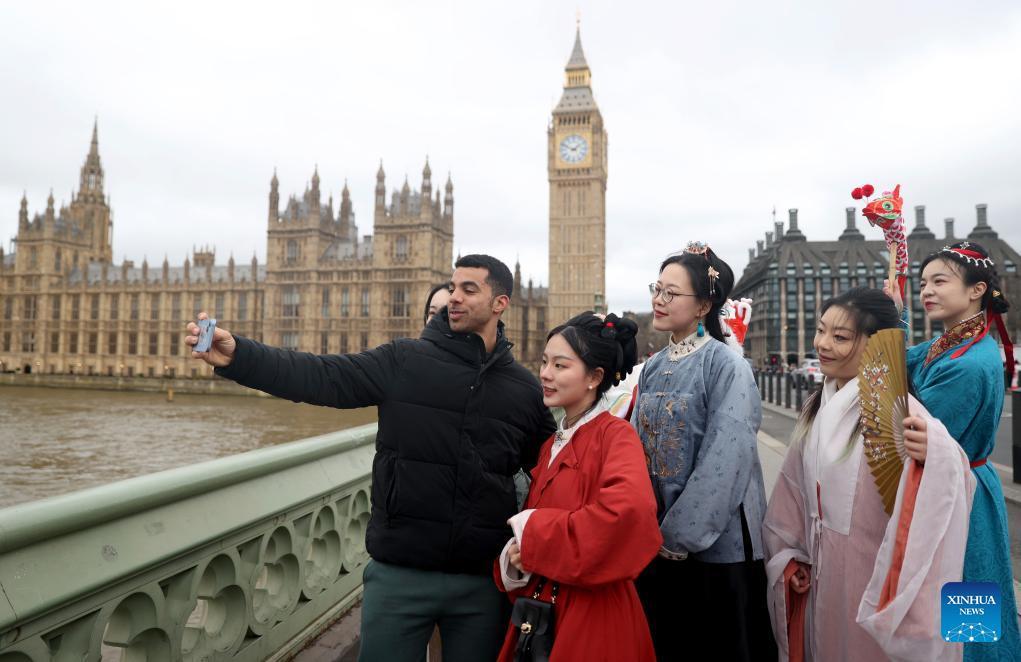
 0 Comment(s)
0 Comment(s) Print
Print E-mail Xinhua, March 21, 2024
E-mail Xinhua, March 21, 2024

Hanfu enthusiasts display Hanfu at the British Museum in London, Britain, Feb. 25, 2024. Hanfu enthusiasts wearing Hanfu, a style of clothing traditionally worn by the Han people, introduced Chinese traditional culture to local people and visitors in London on Sunday. (Xinhua/Li Ying)
Dressed in traditional Chinese clothing, Ling Qianhui and her friends wander in charming violet and peach blossoms with their flowing sleeves and embroidered skirts, making a picturesque spring scene.
This was the scene at the Nanning Garden Expo Park, south China's Guangxi Zhuang Autonomous Region. "It's quite easy to take stunning photos here dressed in traditional attire especially with the flowers blossoming in the spring," Ling said.
The passion for traditional Chinese attire, also known as Hanfu, has swept across the country in recent years, with bevies of youngsters dressed in Hanfu becoming a common sight in many tourist attractions.
In the eastern city of Suzhou, which is known for its classical Chinese gardens, the horse-faced skirt has gained more fondness among young people ahead of spring. It is a type of Hanfu featuring a high and flat front with pleated sides that originated from the Song Dynasty (960-1279) and prevailed in the Ming and Qing Dynasties.
"Hanfu used to be an obscure subculture about 10 years ago," said Zhao Xi, a 27-year-old Hanfu enthusiast. "But now, people won't be surprised seeing passers-by in Hanfu."
"More young people like to wear traditional clothing when traveling because they have realized that their cultural identity is related to Hanfu and it has become a fashion," said Pan Lusheng, chairman of the Chinese Folk Literature and Art Association.
"It is a spontaneous trend and demonstrates the resurgence of traditional culture," Pan added.
Chen Chen, a Hanfu lover from Hunan Province, has collected many traditional clothes in various styles. For each trip, she would carefully select different Hanfu according to the scenery of the scenic spots. When buying traditional attires, in addition to color matching and style, Chen also pays attention to the embroidery patterns and their cultural value.
"It is not just for taking pretty pictures, but also to understand the cultural connotation behind the clothing and the feeling of ancient Chinese poems and essays in an immersive way," Chen said.
"The embroidery pattern on the clothes hides the words of our ancestors. For example, the chrysanthemum pattern implies a long life and a peaceful residence," said Bi Hong, an embroidery artist dedicated to conducting traditional clothing research and protection for almost 28 years.
From Bi's perspective, Hanfu is one of the manifestations of China's excellent traditional culture. She also believes that the Hanfu craze will continue to grow. She expects more enthusiasts to devote themselves to the protection, inheritance and innovative development of traditional Chinese clothing through learning, research and practice.

Hanfu enthusiasts demonstrate traditional Huazhao Festival ceremony at the Filoli Historic House & Garden in Woodside, California, the United States, March 2, 2024. An event was held by the Northern California Hanfu Association here on Saturday in celebration of the Huazhao Festival, the flower goddess' birthday. (Photo by Liu Yilin/Xinhua)
Go to Forum >>0 Comment(s)